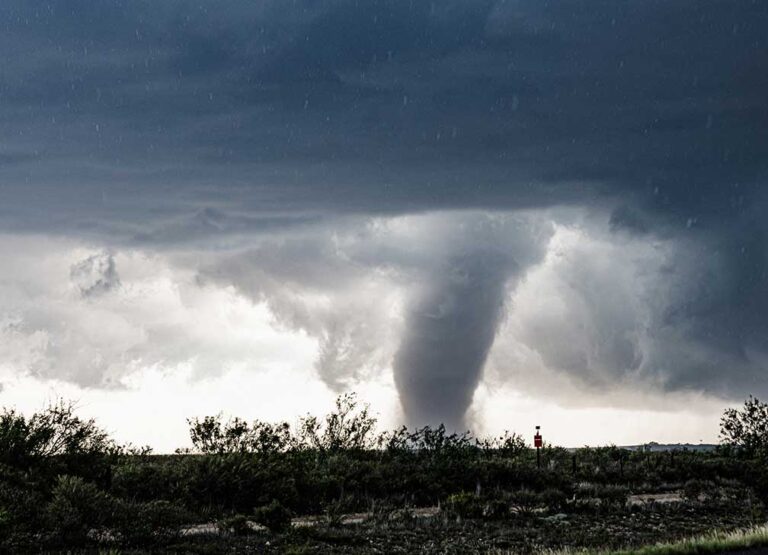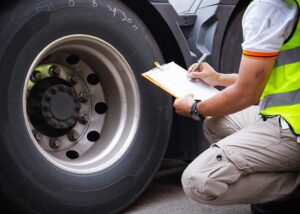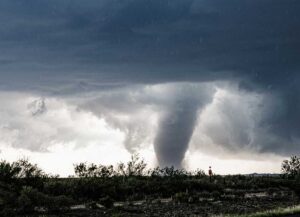If anyone doubts that severe weather season is upon us, all they have to do is take a look at what happened in the eastern U.S. in mid-March. Over a three-day period, nearly 100 tornadoes were reported in 13 states stretching from the Great Plains to Pennsylvania. Unfortunately, over 40 people were killed in the storms, some of which were so powerful they knocked buildings from their foundations, shearing the iron rods that held them in place.
Tornadoes are atmospheric phenomena considered to be the most severe storms on earth. They are common in the U.S., with the potential to form in all 50 states.
“Tornado alley” — the area between the Rocky Mountains and Mississippi River — is the most likely area of the country for tornadoes to occur as warm, moist air from the Gulf collides with leftover arctic air plunging southward in the spring months. For long-haul truck drivers, the interstates in this region are some of the most heavily traveled in the country.
Tornadoes, of course, can toss an 18-wheeler aside like a Tinker Toy. When facing a tornado on the road (or anywhere), it’s not a question of saving your load. Your life is what matters.
So, what are truckers supposed to do when their routes take them through the heart of tornado country?
Well, the obvious answer would be to stay off the roads when severe weather is anticipated — but we all know that’s not a realistic plan for a long-haul driver. Instead, you can be ready for tornadoes by keeping a few tips in mind.
Preparation
A little bit of preparation can go a long way when it comes to staying safe in severe weather season.
All truck cabs should be equipped with a NOAA weather radio — and drivers should keep that radio turned on whenever they’re in the truck, even on sunny days. These radios sound alarms warning listeners of severe weather. They’re especially valuable during tornado season.
While smartphone apps can do the same thing, it’s difficult to keep the apps updated to continuously cover the area in which you’re driving. NOAA weather radios reach all points of the country on a single frequency, so no matter where your travels take you, your radio will always alert you when severe weather is possible.
Terminology
While having a NOAA weather radio is a great first step in preparing yourself to travel during tornado season (or any time of the year), it’s important to understand the terminology the National Weather Service uses when issuing tornado alerts.
There are two primary terms — tornado watch and tornado warning.
• Tornado Watch
A tornado watch means that the atmosphere is primed for tornadoes to form. A watch is normally issued for a widespread area covering several counties within a state or multiple states. It’s important that you’re familiar with the counties you’ll be traveling through; tornado watches don’t always mention cities or other geographic areas.
It’s important to note that a tornado watch does NOT mean a tornado is imminent. A tornado “watch” serves a reminder that a tornado could form at any time during the watch period, particularly near severe thunderstorms.
Truckers should keep an eye on the sky when driving through a tornado watch area. Tornado watches are often extended, usually to the east, so westbound drivers may find themselves driving into watch areas as the day moves along.
What to do during a tornado watch:
Most importantly, when driving through a “watch” area, truckers should keep an ear to their weather radio and an eye on the skies.
When you’re driving along interstates, forming storms can often be spotted miles away as an area of the sky darkens. Keep an eye out for low-hanging clouds, signs of rotation in the cloud base, wind shifts, heavy extended thunder, torrential rain and hail. All of these are signs a tornado may be in the process of forming, even before a warning is issued.
At nighttime, be on the alert for flashes of light low to the ground. These may be power lines falling and sparking in high winds — or they could even indicate an approaching tornado.
• Tornado Warning
A tornado warning means a weather radar has indicated the formation of a tornado or that a storm spotter has reported a funnel cloud or tornado on the ground. A warning is serious business: Anyone within the warning area is in imminent danger and should take life-saving measures.
Warnings are normally for a much smaller geographic area than watches and often mention specific towns that are in the path of the tornado. Like watches, warnings are often extended eastward if the tornado continues to be a feature on weather radar. Travelers should keep in mind that tornado warnings are often issued in clusters. A line of thunderstorms stretching from north to south will often create numerous tornado warnings as it moves to the east. Simply driving around the tornado threat is seldom a realistic possibility.
What to do during a tornado warning:
When a tornado warning is issued for your area, your first step should be to get off the road. Take an exit and find a truck stop, a hotel, a shopping mall or some other substantial structure and GO INSIDE.
There is no worse spot to be in a tornado than in your truck, so don’t simply find a parking spot and plan to weather out the storm.
If you’re in an area without services or you can’t exit the highway, pull to the shoulder and look for a ditch or other low-lying area.
It may seem counterintuitive, but you should climb out of your truck and take a pillow or blanket with you; do NOT remain in your vehicle. Lie down in the ditch and cover your head and upper body. Most injuries during tornadoes are the result of flying debris. With any luck, your low location will keep the debris flying overhead.
Also, be careful about the location you choose for shelter. Don’t stay too close to your truck, as a tornado can easily overturn even the heaviest loads. Also, make sure you aren’t taking cover beneath power lines.
If you’re forced to remain in your truck during a tornado:
Move into the sleeper area or away from windows, and cover your head and upper body with blankets or pillows. If possible, fasten your seatbelt to protect you from injury should the tornado overturn your rig. Once the storm passes, do NOT climb out of your rig without checking for downed powerlines. If you spot a downed powerline nearby, stay in your truck and call 911.
What NOT to do in a tornado
There are several ways to protect yourself if caught in a tornado … and there are also ways to place yourself at risk even when the solution seems to make sense.
- Don’t try to outrun or outmaneuver a tornado.
These storms travel at 30 to 70 mph, and unlike you, they aren’t restricted to roads. Tornado paths are unpredictable, and they may jump in one direction or another without warning. You can’t outsmart a tornado, so it’s best to get off the road.
- Don’t park beneath an overpass.
While you may want to protect your equipment and your load, do NOT select the often-chosen method of parking your rig under an overpass. While that overpass might protect your paint job from hail, it also forms a wind tunnel. Overpasses can increase tornado winds to tremendous force and suck large debris through the opening. This is a life-threatening situation, and any protection you think you might be offering your truck is not worth the risk.
- Don’t keep going when other traffic has stopped.
We’ve all seen the videos of highway cameras catching 18-wheelers and other vehicles driving directly into the path of a tornado, even as other vehicles are pulled to the side of the road. Again, be on the alert. If a line of vehicles is stopped during severe weather, it’s likely for a reason. Don’t be the hero who delivers your load on time no matter the cost.
Tornadoes are short-lived events. Save time, heartache, and your life by simply preparing for any eventuality and following these easily memorized tips.
Since retiring from a career as an outdoor recreation professional from the State of Arkansas, Kris Rutherford has worked as a freelance writer and, with his wife, owns and publishes a small Northeast Texas newspaper, The Roxton Progress. Kris has worked as a ghostwriter and editor and has authored seven books of his own. He became interested in the trucking industry as a child in the 1970s when his family traveled the interstates twice a year between their home in Maine and their native Texas. He has been a classic country music enthusiast since the age of nine when he developed a special interest in trucking songs.








